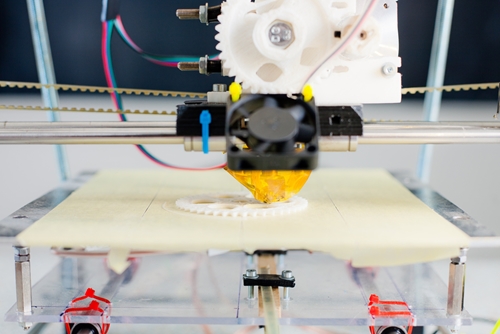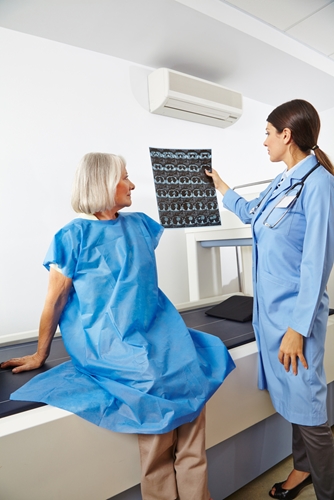In an article published in the November-December issue of RadioGraphics, a group of radiologists claim that 3-D printing could change the medical-imaging industry. This piece comes on the heels of medicine's general embrace of the production technique which many have deemed revolutionary.
The authors contend that radiologists could use these printers to craft 3-D models of body parts from scans.
"While use of advanced visualization in radiology is instrumental in diagnosis and communication with referring clinicians, there is an unmet need to render Digital Imaging and Communications in Medicine (DICOM) images as three-dimensional printed models capable of providing both tactile feedback and tangible depth information about anatomic and pathologic states (sic)," the authors wrote.
Medicine Welcomes Printing Innovation
Over the last three years 3-D printing has catalyzed a variety of medical innovations, reported The New Yorker.
In June 2011 doctors at Hasselt University's Biomedical Research Institute managed to perform a jaw transplant using a 3-D-printed implant made of titanium, reported the British Broadcasting Company. Months later in February 2012 physicians at the University of Michigan's C. S. Mott Children's Hospital used the technology to create a bioresorbable airway stent for an infant suffering from tracheobronchomalacia, a condition that weakens the trachea and makes it prone to collapse. Doctors implanted the device in the child's airway. According to The New England Journal of Medicine, the child made a full recovery. And earlier this year, a surgeon at Nicklaus Children's Hospital in Miami prepped for a tricky aortic surgery with a 3-D-printed heart replica made of rubber, reported CNN.
"Without the model, I would have been less certain and that would have led me naturally to make a larger incision that could possibly cause more pain and a longer recovery time," Dr. Redmond Burke, director of the hospital's pediatric cardiovascular surgery and the physician who performed the procedure, said in an interview with the news network.
This production method is also changing the way pharmaceutical companies manufacture prescription drugs. In August the U.S. Food and Drug Administration approved the first 3-D-printed medication, reported The Washington Post. According to Gizmodo, the American Heart Association is funding research in a similar vein. Technologists associated with the organization are developing computer algorithms and software that would allow physicians to create customized medication tuned to each individual patient's body chemistry.
Physicians and health care providers find these developments encouraging, as they believe 3-D printing could enable medical centers to engineer implantable organs and tissues.
Tallying The Costs
According to CNN, one single industrial-grade 3-D printer and the accompanying software cost around $100,000 – less than the average computed tomography or magnetic resonance imaging machine. And it appears that prices will only get lower.
The Massachusetts Institute of Technology designed a printer that, if massed produced, would cost $7000, reported Wired. Unlike most industrial 3-D printers, MIT's creation, called MultiFab, can construct multi-material products in one single printing session.
"The multi material 3-D printers available out there are insanely expensive," Javier Ramos, the project's lead researcher, told the magazine. "And they're very limited in the number of materials they can print and the software accessibility. So we decided to build our own multi-material 3-D printing platform, with the idea that we're going to make it inexpensive, and a software platform that we would keep open and hackable."
What This Means For Radiology
While the writers of the RadioGraphics article express enthusiasm over the prospect of integrating 3-D printing technology into radiology, they do express some reservations, including concerns over cost, physician training and the lack of industry-wide guidelines.
However, the authors clearly believe the technology has the potential to transform the specialty.
"Radiologists should at a minimum be familiar with 3-D printing as it relates to their field, including types of 3D printing technologies and materials used to create 3D-printed anatomic models, published applications of models to date and clinical benefits in radiology," they wrote.
This isn't necessarily a novel idea. During the 2013 annual meeting of the Radiological Society of North America, Dr. Frank Rybicki from Brigham and Women's Hospital presented research on the topic, reported Health Imaging.
"Radiologists should be very interested in the process and should capitalize on it," Rybicki said during his presentation. As for the financial and implementation-related risks involved in the widespread implementation of 3-D printing: "I think all of these factors will be overcome and we'll have more widespread use of the 3-D printing, showing that it definitely will benefit patient outcomes."
Ronny Bachrach
Latest posts by Ronny Bachrach (see all)
- Konica Minolta Debuts First-of-Its-Kind Digital U-Arm System at AHRA - July 27, 2016
- Researchers Detect Signs Of Stroke Risk Using MRI - June 27, 2016
- Imaging Biz: Q&A with David S. Channin MD: How to Make PACS Patient Centered - June 22, 2016










